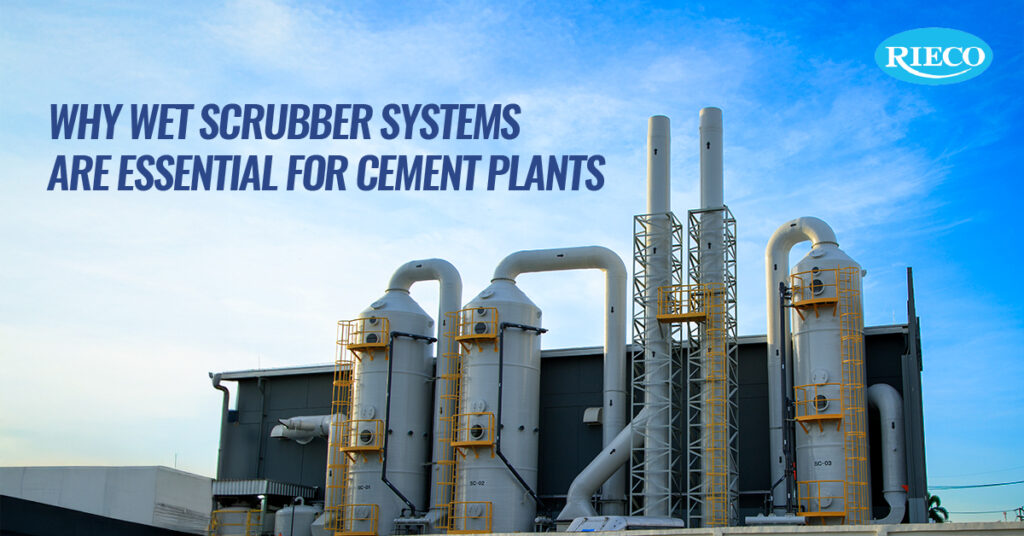Why a Wet Scrubber System is Essential for Cement Plants

Scrubbers
Industries such as chemicals, fertilisers and steel manufacturing generate significant emissions, including particulate matter, corrosive gases such as SO₂, NOₓ and HCl, and fine aerosols released during high‑temperature reactions, material handling and combustion processes. These emissions pose regulatory, environmental and operational risks that range from non‑compliance penalties to equipment corrosion, product contamination and unplanned downtime.
To address these challenges, many plants adopt a wet scrubber system, a robust solution capable of capturing both particulates and acid gases in one integrated unit. Below, we break down how wet scrubbers work, when and how they’re applied in cement plants, and what makes them essential in meeting stringent emission norms.
What is a wet scrubber system?
A wet scrubber system is a pollution control device where a contaminated gas stream is brought into contact with a scrubbing liquid (usually water or a reagent solution). Pollutants transfer from the gas to the liquid via absorption, impaction, diffusion, and other mechanisms.
Key points:
- Packed-bed / spray towers: Best suited for gas absorption and soluble pollutants (e.g., SO₂, HCl).
- Venturi scrubbers: High-energy devices ideal for fine particulate (PM) removal because of intense turbulence.
- Many wet scrubbers achieve >95% particulate removal under optimal design conditions.
- Materials of construction, liquid flow rate, droplet size, and pressure drop are critical design levers.
How does a wet scrubber system help cement plants comply?
Wet scrubbers are especially valuable because they can target multiple pollutants in a single device.
- Dual-pollutant control:
- PM removal via droplet–particle impaction (Venturi/impingement types).
- SO₂/HCl capture via reagent absorption (e.g., limestone, caustic), similar to FGD practice.
- Fine particulate performance:
- Venturi scrubbers can achieve very high fine-PM collection when operated at higher pressure drops (with energy trade-offs).
- Integration flexibility:
- Applied as primary control or polishing downstream of cyclones/ESP/baghouses, and in retrofits with space or moisture constraints considered (compact arrangements are possible).
What types of wet scrubber systems are used around cement processes?
Different scrubber designs meet different process requirements:
- Venturi scrubbers – High-energy PM control (including sub-micron fractions); often used on kiln or cooler gas where high removal is required.
- Packed-bed / spray-tower scrubbers – Gas absorption of SO₂/HCl; best where dust loading is moderate or after pre-collection.
- Fibre-bed / mist eliminators – Capture acid mist or aerosols downstream of absorbers, improving stack clarity and corrosion control.
How do wet scrubbers compare to other options in cement service?
While wet scrubbers are versatile, other systems are also used in cement plants:
- Baghouses (fabric filters): Excellent PM control; not for acid-gas capture without upstream chemistry changes. Often used with scrubbers or as alternatives where only PM is targeted.
- ESPs: Low pressure drop; PM control depends on particle resistivity and gas conditions; no acid-gas removal without additional systems.
- Dry/semi-dry sorbent injection (DSI/SDA): Good for acid gases with low water use; may need a downstream baghouse for PM; choice depends on SO₂ load, temperature window, and lifecycle cost.
How do you decide when a wet scrubber is the right choice?
Choosing a wet scrubber depends on both emission profiles and plant constraints:
- Pollutant profile: Need both PM and acid-gas control in one device (e.g., SO₂ spikes not fully taken up by the alkaline kiln dust/product).
- Gas conditions: Temperature and moisture compatible with wet scrubbing; ability to handle the generated liquid effluent/scrubber sludge.
- Performance target: Required outlet PM/acid-gas limits (e.g., under national standards or permit conditions) and need for high fine-PM capture.
- Energy & OPEX: Venturi efficiency rises with pressure drop—higher energy for higher capture; evaluate fan power and reagent use.
- Integration & footprint: Space for towers/recirculation loops, corrosion-resistant scrubber materials, and a mist elimination stage.
- By-product handling: Slurry management, water balance, and solids disposal/recovery consistent with site EHS practices.
Conclusion
For kilns, coolers, and material-handling lines, a wet scrubber system offers dual control of particulates and acid gases, helping cement plants meet tightening emission limits while protecting equipment and uptime. With correct selection (Venturi vs packed-bed), thoughtful integration, and disciplined monitoring, wet scrubbers provide a proven, compliant path to cleaner stacks in cement manufacturing.




